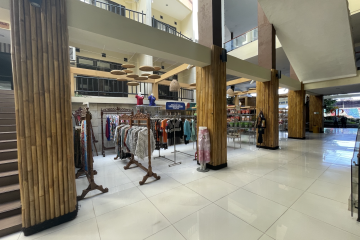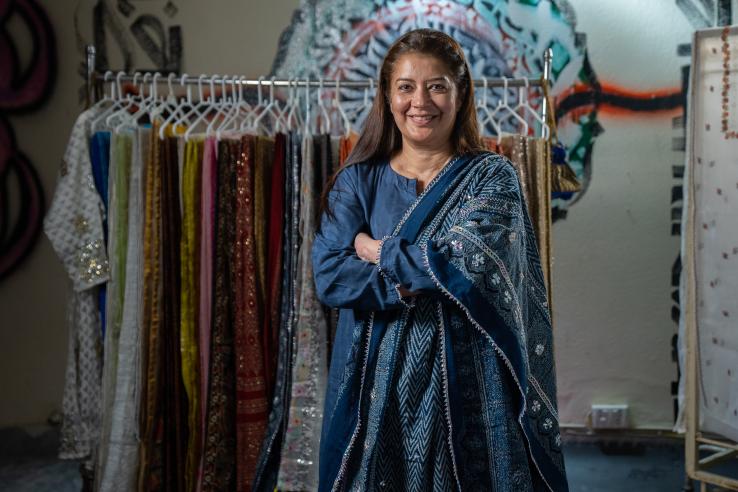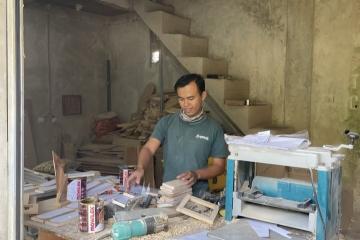
Beyond easy metrics: Evaluating what matters for women entrepreneurs

This piece was originally published on LinkedIn.
Women entrepreneurs deserve measurement systems built around them, not the other way around.
“What does it mean to be a successful entrepreneur?”
Last year, my team at CARE and I conducted qualitative research as part of our baseline survey for Strive Women program in Peru, Pakistan, and Vietnam. This was one of the questions we asked.
Some of the answers were what you’d expect: stable profit, good sales, many customers. But most spoke about something deeper—ability, confidence, and leadership—qualities that are not easy to measure. Women told us:
“A successful businesswoman can take care of her children and both sides of the family while running her business.”
“I believe that a successful businesswoman is a leader.”
“A successful business entrepreneur is one who knows her customer.”
Other women spoke about the ability to overcome challenges like the Covid-19 pandemic and harmful social norms. Success was also defined as “wins” in their household, such as their children achieving good marks in school.
These responses challenged me to reflect on the limitations of how we typically define and measure “impact” in our programming. It's easy to measure and quantify income increases or asset accumulation, but much harder to capture all the nuanced ways that women's lives change over time.
Of course, this challenge isn’t new. Researchers often wrestle with the best way of measuring concepts like “empowerment” and “quality of life.” These are terms that often feel too contextual or dynamic to be captured through traditional survey instruments.
But here’s what I worry about: our pursuit of precision can sometimes lead to inaction. As researchers, we spend a lot of time debating how to choose the right research question, the best indicator, or the most rigorous method. And that rigor is important because it helps us build credible evidence. But it can also create a sense that trying something new is too risky because it opens us up to criticism.
That hesitancy has consequences. When we choose not to measure something, it may get left out of programming entirely. Not because it doesn’t matter, but because we couldn’t figure out how to ask it in a survey.
I've been inspired by researchers like J-PAL affiliated professor Rachel Glennerster, who argues:
"People have said empowerment is a process [so] it is impossible to quantify—and my reaction is no! It's just hard. That doesn't mean it's impossible."
The difficulty of measurement doesn't justify abandoning the attempt. Instead, it calls us to be more creative and participatory in our approach.
What was our approach?
For Strive Women, we made a deliberate choice: “outcomes” would mean improvements across all aspects of women entrepreneurs' lives based on what women told us matters. As mentioned above, these included concepts like: business achievements, their ability to navigate challenges, recovery from the pandemic, and household successes. Drawing on past research and these direct conversations with respondents, we organized our program and measurement framework around four core pillars:
- Financial resilience: Ability of women entrepreneurs to prepare for, withstand, and recover from shocks
- Business management and growth: Ability of women entrepreneurs to use proactive strategies and tools to manage and grow their business
- Confidence and control: Confidence in one's ability to manage and grow their business
- Quality of life: Ability to balance household and business responsibilities, and finances
Our participatory approach to measurement didn’t stop at framework development. We wanted to ensure each question was framed to capture varying individual needs and challenges. A good example is our “decision-making and control” module. Rather than assuming that more control is always better, we asked entrepreneurs how much control they currently have and how much they’d want to have. This helped us understand whether a woman entrepreneur felt empowered or burdened by individual responsibility. Through focus group discussions, we also recognized that sharing decisions isn’t inherently a sign of less power; for many women, it reflects the importance of trusting and collaborating with your partner or family member. In short, we aimed to measure control not in the abstract, but in relation to women’s own preferences and lived experiences.
Using this framework and questionnaire (the full text is in the annex of our baseline survey report), we found insights we might have missed if we had only focused on “quantitative” indicators. Specifically, the data challenged common stereotypes that portray women entrepreneurs in emerging markets as low-productivity business owners. Instead, the data reveals that the women surveyed are driven, strategic, and tenacious. They manage and grow their businesses despite facing significant challenges.
- Resilient, but reactive. About half of women entrepreneurs have the necessary capital to sustain their business for three to six months after a shock, and many rely on reactive rather than proactive strategies to respond to emergencies.
- Strong foundations, but targeted support is needed. Women entrepreneurs have a strong foundation in business and financial management, but need additional business management skills, digital tools, and financial support to grow their businesses.
- Confidence exists, but barriers persist. Women entrepreneurs are confident, but external barriers and other constraints hold them back from business growth.
- Multiple responsibilities create competing demands. Competing household, financial, and business responsibilities affect quality of life and business outcomes.
This isn’t a perfect framework. Even since publishing our baseline survey report, I’ve come across important recommendations on how we could improve or add certain indicators. That’s expected and even welcomed! I believe measurement approaches should evolve, be dynamic, and flexible, while still allowing us to track meaningful change over time.
More answers, more questions
Our baseline raised as many questions as answers, especially around the dynamic nature of what we found:
- How does confidence evolve over time? Does it grow steadily with exposure to training and tools, or does it fluctuate as entrepreneurs encounter new challenges and trade-offs?
- What drives resilience and risk management? How do women's risk preferences and coping strategies shape their financial decisions? What influences their ability to manage business shocks?
- How do relationships shape outcomes? How do social networks, mentorship, and family dynamics influence women entrepreneurs' ability to manage and grow their business? Does financial independence lead to greater family support or added strain?
These questions should remind us that women’s lives are fluid, and meaningful measurement approaches should similarly be fluid to capture evolving realities. Practically, that might mean adding new indicators mid-project because participants raise outcomes we hadn’t originally considered, or disaggregating data by different sub-groups. It could involve incorporating more in-depth qualitative interviews to complement survey findings or designing flexible modules (short sets of questions that can be added or swapped out over time). This way, we preserve the consistency needed for longitudinal analysis, while still leaving space to respond to what we learn along the way.
With this in mind, I’m especially excited to launch our inaugural Strive Women financial health scorecard. This lean, fifteen-question survey we’ll use every three to six months to track women entrepreneurs’ evolving realities and needs. Insights from our baseline survey showed us how financial health shifts over time, so we’re adding this tool to our measurement approach. More info on that to come!
Let’s embrace the mess
Throughout this process, I've been struck by what happens when we listen carefully to women and understand what they value: we can create richer, more meaningful measurement tools that give us practical insights into their lived experiences and make more effective programming.
There’s no shortcut to this type of measurement. It will require going beyond standard indicator banks and having conversations with program participants, partners, and on-the-ground staff to build a framework that reflects their realities. And as those realities shift, our frameworks should too. We need to be comfortable revisiting and refining our measurement approaches as we learn more, even mid-project. It shows we’re paying attention.
Ultimately, as researchers, we have a responsibility to push beyond the easy metrics and grapple with the messiness and complexity of the lives we aim to improve.
Tanvi Jaluka is an international development and gender researcher. For ten years, Tanvi has designed and evaluated programs that empower women economically, focusing on entrepreneurship and financial inclusion in emerging markets. She has deep expertise in impact evaluations, quasi-experimental methods, and monitoring and evaluation tools for development programming. She has worked across diverse regions, including Asia, Africa, and Latin America, and is fluent in Hindi.
Currently, she is the research lead for CARE USA’s Financial Inclusion and Women’s Entrepreneurship team. Previously, she led projects at Innovations for Poverty Action and the Center for Global Development. Tanvi received a Master’s in Public Policy from UC San Diego, and a Bachelor’s in International Studies from Vassar College. She lives in San Diego.
Related Content

Can product curation overcome challenges in MSME market expansion? Opportunities for impact evaluation

Using alternative data and artificial intelligence to expand financial inclusion: Evidence-based insights

